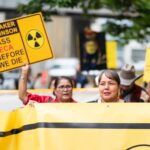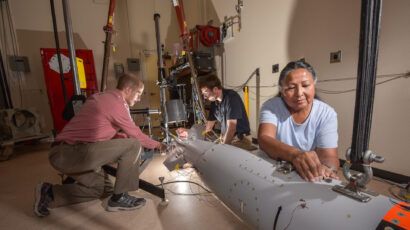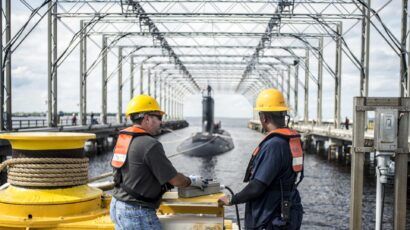Fukushima’s lessons, unlearned in America?
By Edwin Lyman | April 11, 2014
On March 11, 2011, the Fukushima Daiichi nuclear plant was struck by an earthquake more powerful than the one it was engineered to handle, and then flooded by a tsunami far higher than it was designed to withstand. In the aftermath of the triple core meltdown that followed, observers around the world pointed fingers at the plant’s operator, TEPCO, for not having prepared for such a disaster, citing Japan’s obvious seismic and tsunami risks. In the United States, a member of the Nuclear Regulatory Commission (NRC), George Apostolakis, said that the accident was “not unthinkable,” implying that TEPCO and the Japanese government should have anticipated and planned for such a catastrophe. In a recent speech, Peter Sena III, the chief nuclear officer for FirstEnergy Corporation, expressed a similar view, faulting the Japanese and boasting that US plants, like the ones in his fleet, are required to meet higher safety standards for environmental disasters.
In fact, it’s highly debatable whether Japanese nuclear regulators and utilities really exhibited a level of negligence out of step with those in other countries with nuclear plants, the United States included. Before the accident, the evidence of the Fukushima Daiichi site’s vulnerability to large tsunamis was inconclusive, giving the Japanese authorities plausible deniability. But today, the NRC and the US nuclear industry won’t have the same excuse if a nuclear plant here suffers a fate similar to Fukushima and contaminates a wide area with radioactivity for decades to come. This is because the evidence is clear that dozens of nuclear plants in the U.S. are at significant risk of experiencing natural disasters exceeding their “design basis”—the conditions that each reactor was designed to tolerate without experiencing severe core damage and a large radioactive release.
The question remains: Armed with that knowledge, what, if anything, is the NRC going to do about it? The answer will hinge on whether the commission accepts the industry’s assertion that the risk to the public from nuclear accidents remains low, even for plants that are out of compliance with their own licensing requirements.
The commission should reject such arguments. With regard to these unpredictable risks, such thinking typifies the “March 10th” tunnel vision that was a major driver of Japan’s inability to prevent the Fukushima disaster.
Soon after the Fukushima meltdowns, the NRC convened a task force of senior staff to evaluate whether the accident had any ramifications for reactors in the United States. The task force came back three months later with a 100-page report containing twelve detailed recommendations for addressing gaps in the NRC’s safety regulations. A key finding was that because of new information on seismic and flooding hazards that has emerged over the decades since most plants were built, “the licensing bases, design, and level of protection from natural phenomena differ among the existing operating reactors in the United States, depending on when the plant was constructed and when the plant was licensed for operation.”
The NRC (and its predecessor, the Atomic Energy Commission) originally required nuclear plants to be protected against the most extreme recorded natural events at their locations, with additional safety margin to account for uncertainties in the historical record. However, the task force noted that seismic hazard estimates had increased for some nuclear plant sites and the current level of flood protection was below the “probable maximum flood” height at others. Overall, the degree of protection differs from one plant to another. To remedy this situation, the task force recommended that the commission require all plant owners to systematically reevaluate seismic and flooding risks at their sites and harden essential safety equipment as appropriate, and to repeat the review every 10 years.
The NRC partly took the advice of the task force and ordered the reevaluation. The seismic reevaluations for plants in the central and eastern United States were due on March 31 of this year. Although the results are not yet public, the NRC disclosed this week (as reported by the trade newsletter Nucleonics Week) that more than three-quarters of the 59 sites that have submitted reevaluations have found that the revised earthquake hazard is greater than the one they were designed to handle. But even though this means that these plants are not in compliance with their original licenses, the commission will not necessarily order them to harden their facilities against the more severe threats.
Instead, these plants will perform further studies to analyze how risky the plants actually are—studies that will take years and cost millions of dollars per plant. The industry’s hope is that these analyses will show that the likelihood of earthquakes strong enough to cause severe plant damage is low enough that the benefit of seismic upgrades would not be worth the cost.
But the problem is that these studies depend on highly uncertain predictions of seismic risk, and they may not even provide useful answers. Although these studies have not yet been done, in a recent letter to the NRC, the Nuclear Energy Institute—the central lobbying organization of the US nuclear industry—asserts that “the current seismic design of operating reactors continues to provide a safety margin to withstand potential earthquakes exceeding the seismic design basis.” This might have some validity—but how big a margin each plant has is unclear.
Where flooding is concerned, however, one cannot make the same argument. Flooding is a “cliff-edge” effect where a few additional inches of water could mean the difference between a site remaining dry and becoming inundated, causing the widespread failure of electrical circuitry that was a root cause of the Fukushima accident. Yet reactor owners are lagging in their reevaluations of flooding risks, with 11 of 25 missing the March 12, 2014 deadline and requesting extensions of at least six months. Plants that find that they are at risk of floods higher than their design bases will have to do detailed assessments to show whether they would be able to cope with flooded conditions and prevent a meltdown—something that eluded the workers at Fukushima Daiichi.
But the industry is already beginning to challenge the possibility that plants determined to be vulnerable to more severe floods may have to add additional defenses. At a March 25 meeting with the NRC, industry representatives expressed concern that the commission may force them to develop mitigation strategies for floods that could only result from events so improbable that they could never occur. To his credit, NRC official Michael Johnson pushed back: “I get a little nervous when I hear people talk about an external event that could not happen.” However, the industry has had an excellent track record in convincing the NRC to limit the extent of its potentially costly post-Fukushima requirements, in part because the press and the public are not paying much attention.
One of the plants overseen by Peter Sena of FirstEnergy, Beaver Valley in Pennsylvania, was among the group that requested extensions to file their flooding reevaluations, because the plant was waiting for data from the US Army Corps of Engineers to complete its calculations. Sena’s confidence in the safety of his plants, therefore, was based on information that he didn’t even have. TEPCO exhibited the same type of complacent attitude until it was shattered by Fukushima.
Let’s not make the same mistake. The assumption that our nuclear plants can handle threats far beyond what they were designed for is simply wishful thinking. The NRC needs to recognize the limits of prediction and insist that plants be upgraded to meet the same standards that they were originally licensed to meet. Otherwise, the NRC will effectively weaken nuclear safety standards at a time when it should be strengthening them.
Together, we make the world safer.
The Bulletin elevates expert voices above the noise. But as an independent nonprofit organization, our operations depend on the support of readers like you. Help us continue to deliver quality journalism that holds leaders accountable. Your support of our work at any level is important. In return, we promise our coverage will be understandable, influential, vigilant, solution-oriented, and fair-minded. Together we can make a difference.
Topics: Analysis, Nuclear Energy














